Tools menu
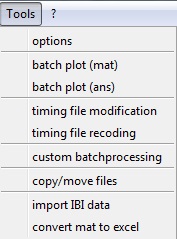
Contents:
Options:
Here you can modify analysis settings for a selected
study folder. It requires a valid selected study folder, because all
modifications will be saved in the "anslabdef.m"-file at the top-level
of the study folder.
| Gui |
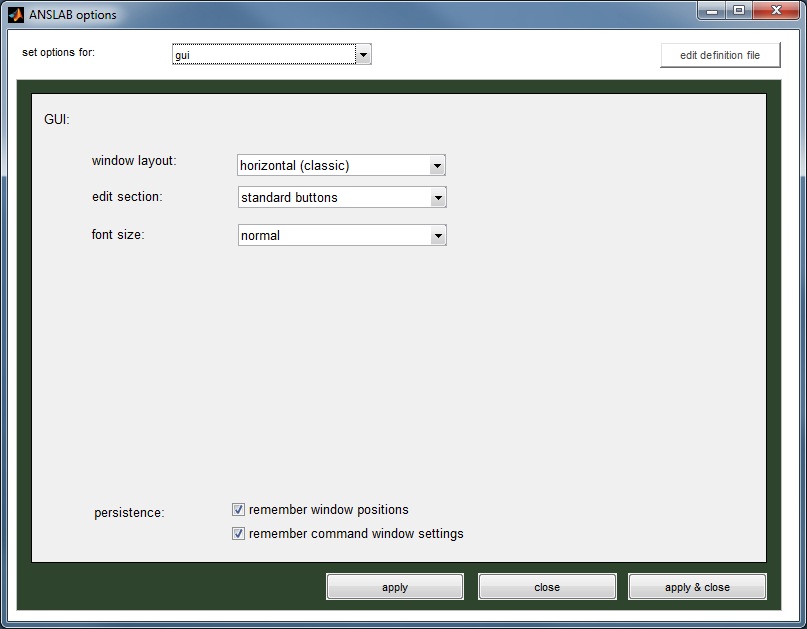 |
| Signal
processing |
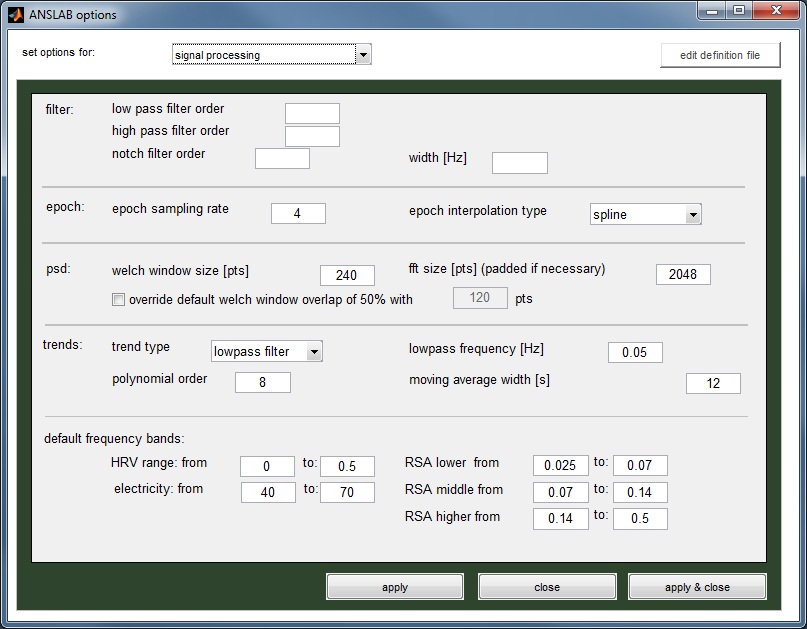
|
| Respcal |
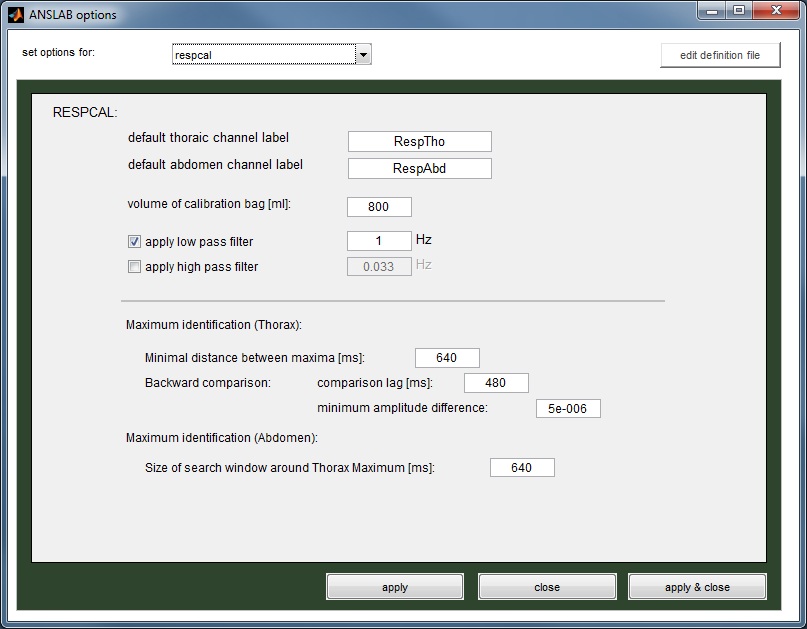
|
| Resp |
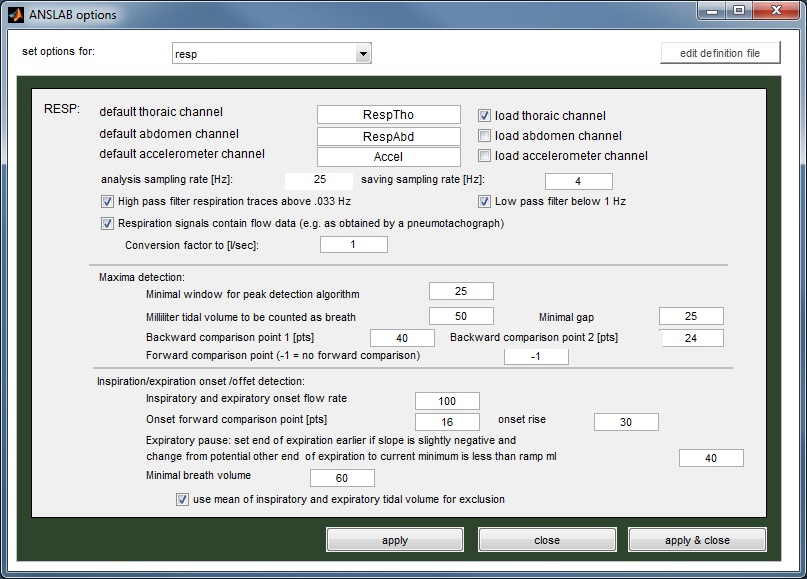 |
| Ecg |
 |
| Icg |
 |
| Eda |
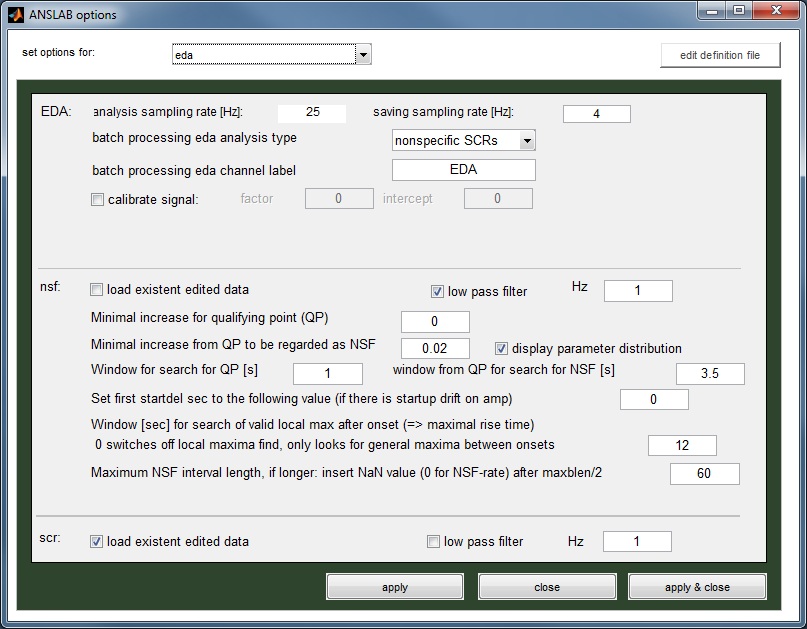 |
| Emg |
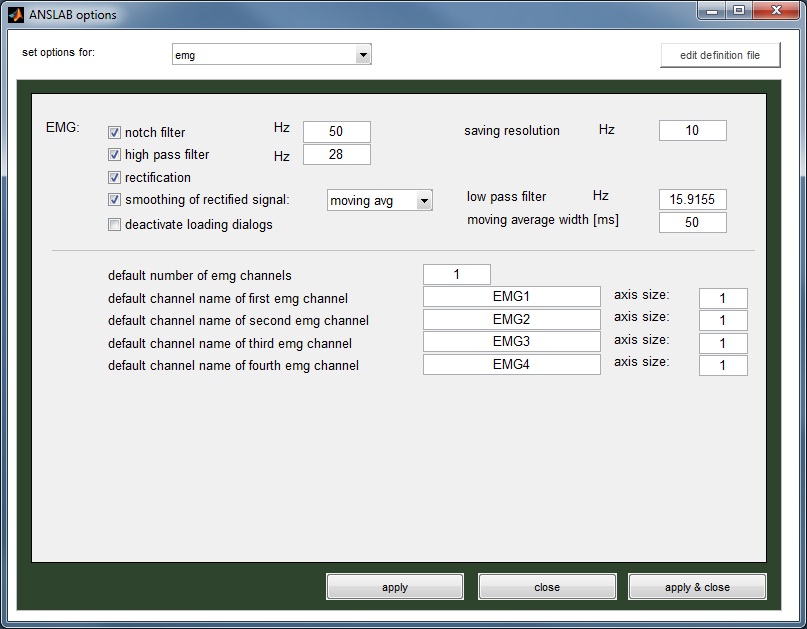 |
| Viewing |
 |
| Accel |
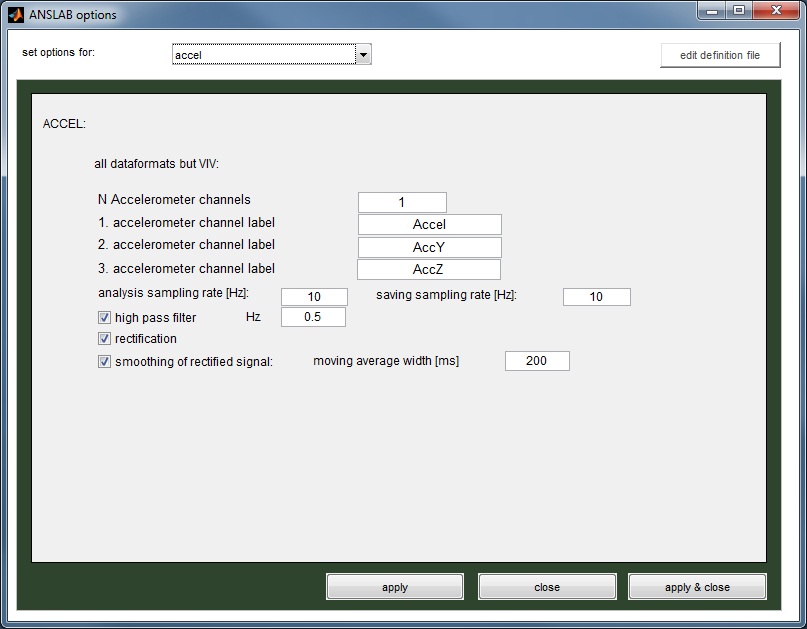 |
Accel
(VIV)
|
 |
| pCO2 |
 |
| Bp |
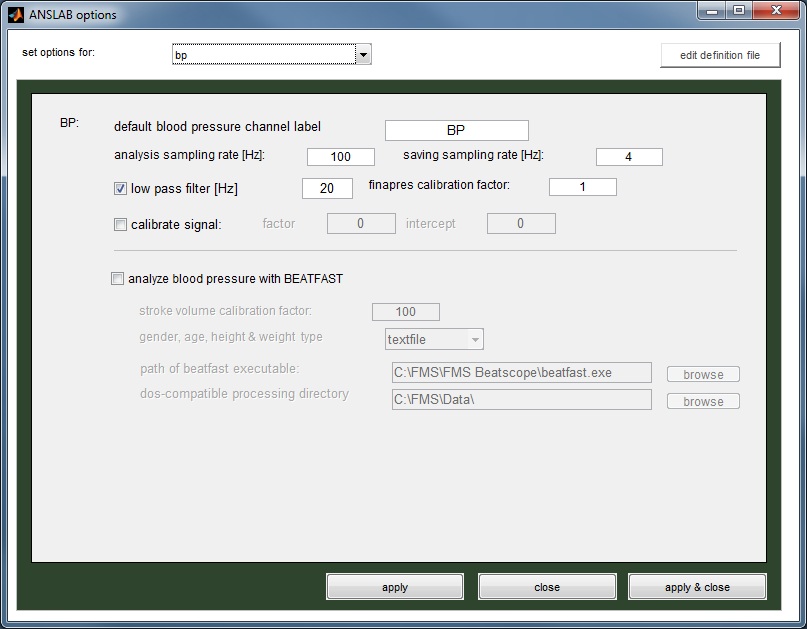 |
Pulse
|
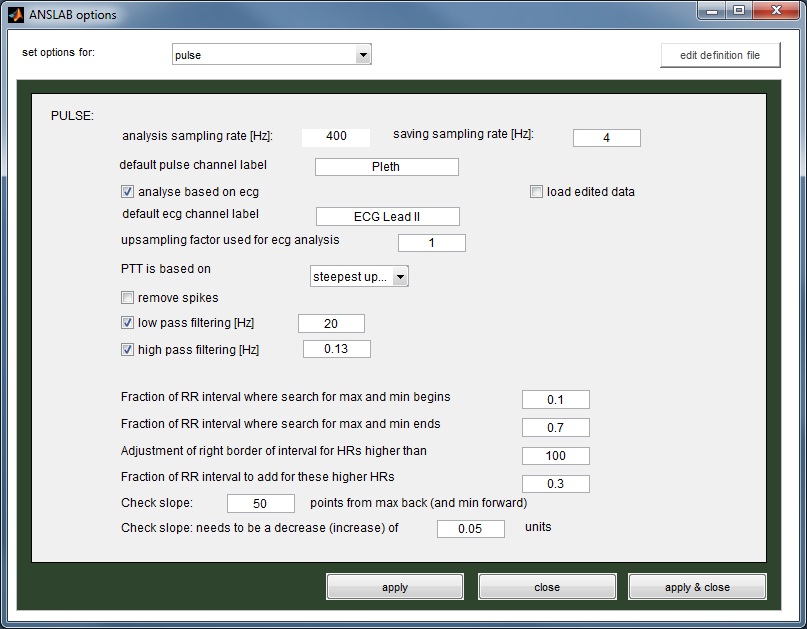 |
Marker
|
 |
Channel
naming
|
 |
Spectral
variability
|
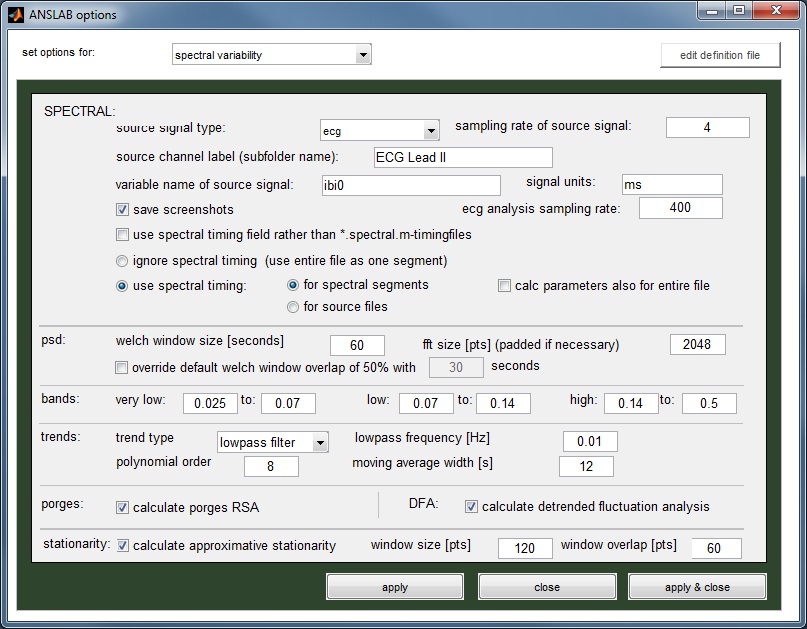 |
Spectral
chaos
|
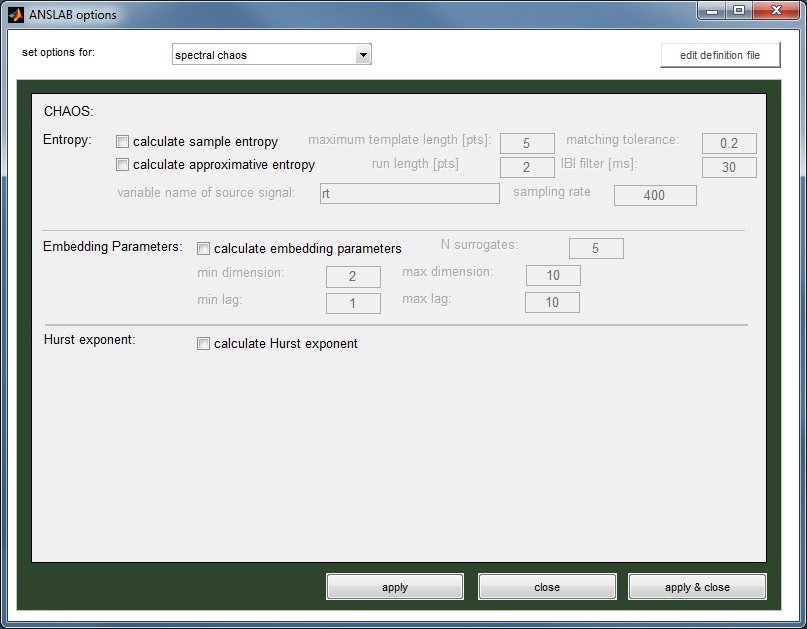 |
Crossspectral
|
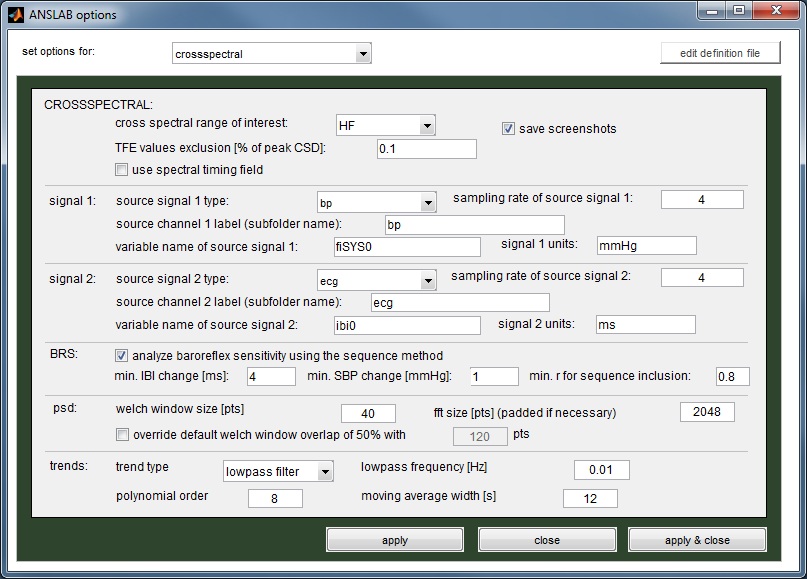 |
Coherence
|
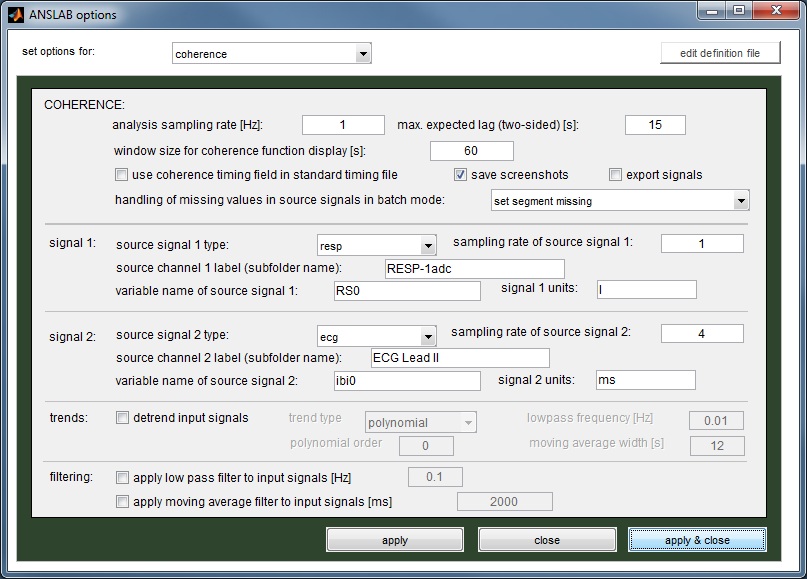 |
Optional
channels
|
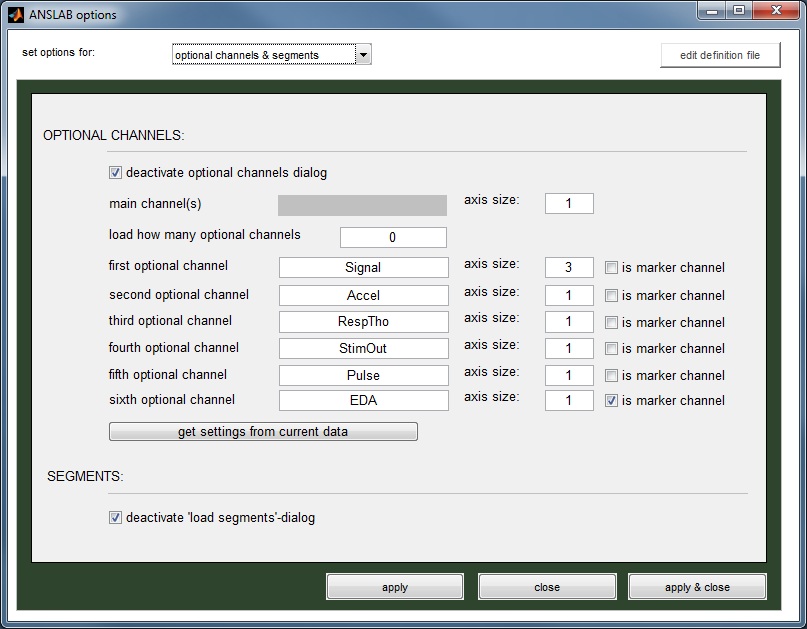 |
Value
export
|
 |
Batch plotting (mat):
Create plots for all your data files to identify outliers and
artefactual data. The procedure is described in detail on the
subject- and sample-plot
Batch plotting (ans):
Create plots for all your evoked data epochs to identify outliers
and artefactual data. The procedure is described in detail on the
subject- and sample-plot
Timing file modifcation:
Move over to datapreparation and describe better
Use this command to modify existing timing files by specifiying a
modification term for each line (interval) or each condition (trigger value)
in the timing files. This tool can help you create smaller subsegments, collapse segments or
modify segments by adding constant offsets. To
start the modifcation process, first load a filematrix containing the
paths of the timing files you wish to modify. Then select the timing file modification
item from the tools menu. You are prompted to select a definition
file, that specifies how each line is to changed. Allowed commands in
the definition file are
Subdivide n;
Subdivfixed n m;
Collapse start;
Collapse end;
Collapse;
Leave;
Drop;
Offset;
Setlength n;
Add [n, m];
Fromonset [n, m];
A sample definition file for line based modification could look like this:
%sample modification
definition file
collapse start;
collapse;
collapse end; add [-1,+1];
drop;
subdivide 3;
leave;
subdivide 2;
subdivfixed 1.5 20;
setlength 3.333;
fromonset [-2, 8];
offset
This will cause ANSLAB to collapse
segments in line 1,2 and 3, enlarging the resulting segment by adding
-1 to the begin and +1 to the end, leave out segment 4,
subdivide line 5 in three equally
sized parts, leave the
segment in line 6 unchanged, and subdivide the line 7 in two equally
sized part. Line 8 will be subdivided in 20 parts of 1.5 seconds
(filling overlap segments with NaN's). Line 9 will be set to a length of 3.333
seconds from the given onset, line 10 will be changed to start 2
seconds before the original onset to 8 seconds after the original
onset. Line 11 is postponed to start with it's original offset.
An original timing file
T = [...
1 0 10.6539
10.6539;...
2 10.6539 21.3077
10.6539;...
3 21.3077 31.9616
10.6539;...
4 31.9616 42.6154
10.6539;...
5 42.6154 53.2693
10.6539;...
6 53.2693 63.9231
10.6539;...
7 63.9231 74.577
10.6539;...
8 74.577 84.577
10;...
9 84.577 94.577
10;...
10 94.577 104.577
10;...
11 94.577 99.577
5];
is changed to the following :
T = [ ...
1 -1 32.9616 33.9616;...
2 42.6154 46.1667 3.5513;...
3 46.1667 49.718 3.5513;...
4 49.718 53.2693 3.5513;...
5 53.2693 63.9231 10.6539;...
6 63.9231 69.2501 5.327;...
7 69.2501 74.577 5.327;...
8 74.57 76.07 1.5;...
8 75.57 77.07 1.5;...
8 76.57 78.07 1.5;...
8 77.57 79.07 1.5;...
8 78.57 80.07 1.5;...
8 79.57 81.07 1.5;...
8 80.57 82.07 1.5;...
8 81.57 83.07 1.5;...
8 NaN NaN NaN;...
8 NaN NaN NaN;...
8 NaN NaN NaN;...
8 NaN NaN NaN;...
8 NaN NaN NaN;...
8 NaN NaN NaN;...
8 NaN NaN NaN;...
8 NaN NaN NaN;...
8 NaN NaN NaN;...
8 NaN NaN NaN;...
8 NaN NaN NaN;...
8 NaN NaN NaN;...
9 84.577 87.910 3.333;...
10 92.577 102.577 10;...
11 99.577 104.577 5];
A sample definition file for condition based modification has an additional
(tab delimited) column before each definition specifying for which trigger values the definition
is applied. It could look like this:
%sample
modification
definition file
1 drop;
3 subdivide 3;
2 leave;
4 subdivide 2;
5 subdivfixed 1.5 20;
7 setlength 3.333;
8 fromonset [-2, 8];
6 offset;
Timing file recoding:
Move over to datapreparation and describe better
Use this command to modify the condition numbers in existing timing
files by specifiying a replacement list. Every condition number in
every file is then replaced according to the replacement list. To
start the modifcation process, first load a filematrix containing the
paths of the timing files you wish to modify. Then select the timing file recoding item from the
tools menu. You are prompted to select a text file, that
specifies how the replacements are to be made. This file must be a two
column tab-delimited text file, the first column containing the
original condition number, the second column the value which will
replace the original. A sample definition file can be
found in the 'anslabutil'-folder in the
' timing'-subfolder, and it's content is shown here:
1 1
2 1
3 2
4 2
5 3
5 3
An original timing file
T = [...
1 0
10.6539 10.6539;...
2 10.6539 21.3077
10.6539;...
3 21.3077 31.9616
10.6539;...
4 31.9616 42.6154
10.6539;...
5 42.6154 53.2693
10.6539;...
6 53.2693 63.9231
10.6539;...
7 63.9231 74.577
10.6539];
is changed to the following :
T = [...
1 0
10.6539 10.6539;...
1 10.6539 21.3077
10.6539;...
2 21.3077 31.9616
10.6539;...
2 31.9616 42.6154
10.6539;...
3 42.6154 53.2693
10.6539;...
3 53.2693 63.9231
10.6539;...
7 63.9231 74.577
10.6539];
Import IBI data:
Moved over to datapreparation and describe better -
remove and shorten - refer to datapreparation
Import raw IBI data recorded e.g., from Polar watch or Actiheart
devices.
Load a batch file specifying the file locations of the raw IBI files.
A one-column text file of raw IBI data is needed for each recording:
855.00
790.00
763.00
765.00
781.00
748.00
...
A folder to place the imported files can be selected. The sampling
accuracy for the imported IBIs is assumed to be 1000 Hz. All values
will be rounded to full milliseconds.
A *.mat file will be created for each imported file which has the
structure of a an edited ecg file. This can be used for further
analysis (e.g., spectral analysis or value export). The IBI raw data can also be
loaded into the ecg analysis module for manual editing of outliers. For this, the
following settings are needed:

 Options
Options
 Batch plot (mat)
Batch plot (mat)  batch plot (ans)
batch plot (ans)  Timing file modification
Timing file modification
 Timing file recoding
Timing file recoding  Custom
batchprocessing
Custom
batchprocessing Copy/move
files
Copy/move
files Import
IBI data
Import
IBI data
 Options
Options
 Batch plot (mat)
Batch plot (mat)  batch plot (ans)
batch plot (ans)  Timing file modification
Timing file modification
 Timing file recoding
Timing file recoding  Custom
batchprocessing
Custom
batchprocessing Copy/move
files
Copy/move
files Import
IBI data
Import
IBI data